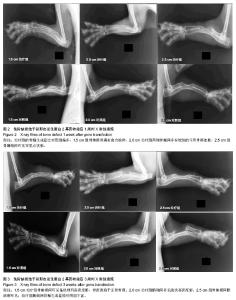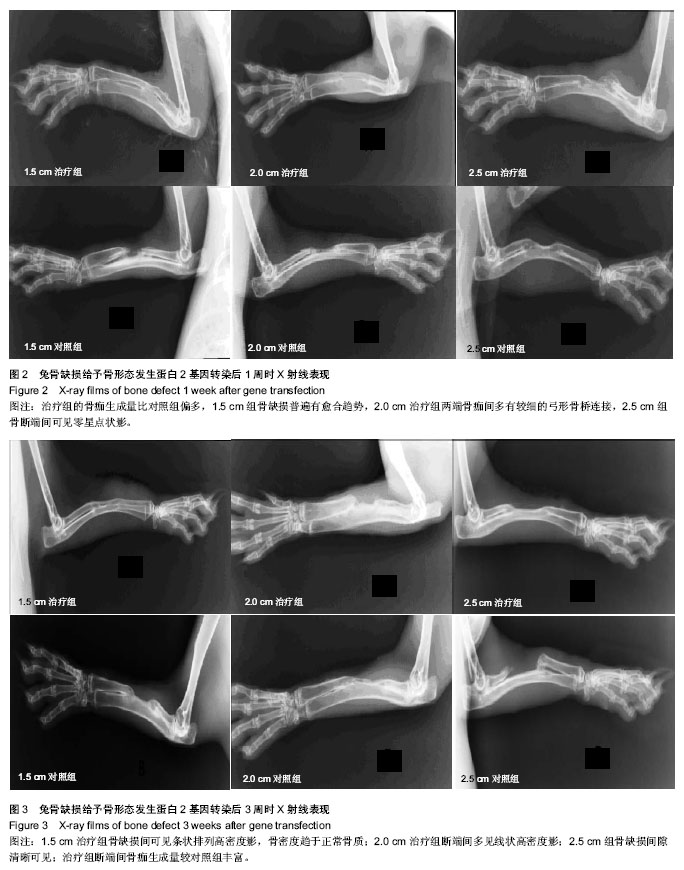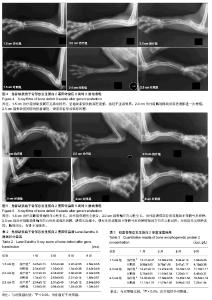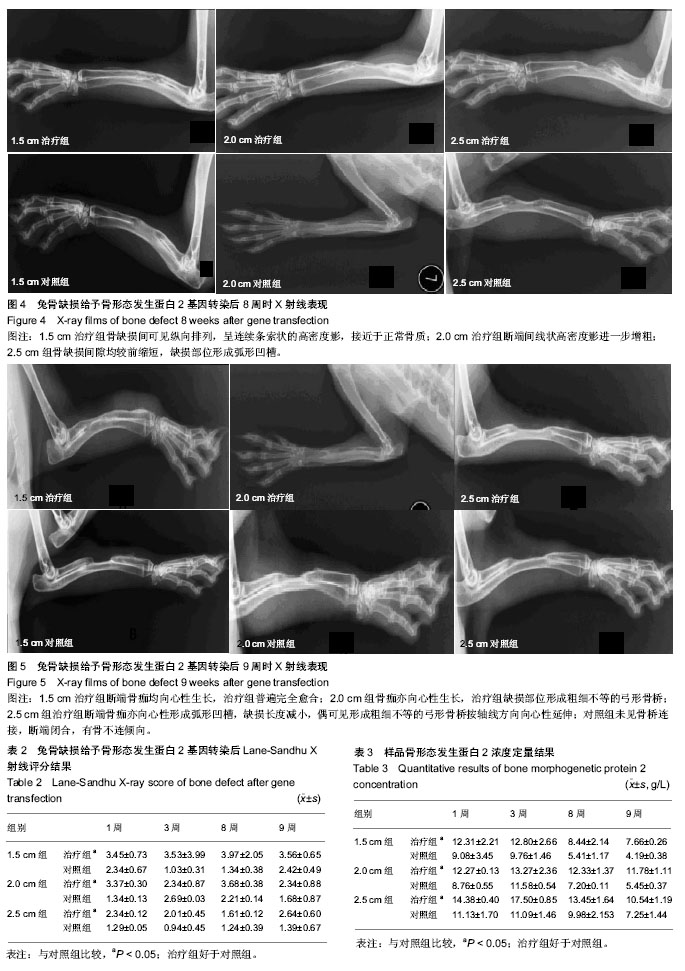| [1] Borrelli J Jr, Prickett WD, Ricci WM. Treatment of nonunions and osseous defects with bone graft and calcium sulfate. Clin Orthop Relat Res. 2003;(411):245-254.[2] Yang HS, La WG, Cho YM, et al. Comparison between heparin-conjugated fibrin and collagen sponge as bone morphogenetic protein-2 carriers for bone regeneration. Exp Mol Med. 2012;44(5):350-355.[3] Lasanianos NG, Kanakaris NK, Giannoudis PV. Current management of long bone large segmental defects. Orthopaed Trauma.2010;24(2):149-163.[4] Park SH, Tofighi A, Wang X, et al. Calcium phosphate combination biomaterials as human mesenchymal stem cell delivery vehicles for bone repair. J Biomed Mater Res B Appl Biomater. 2011;97(2):235-244.[5] Imai Y, Takaoka K. Bone fracture and the healing mechanisms. The role of BMP signaling in fracture healing. Clin Calcium. 2009;19(5):667-672. [6] 徐晓峰,李阳,钱栋,等.骨形态发生蛋白2和血管内皮生长因子mRNA在股骨骨不连大鼠损伤区域的动态表达[J].中国组织工程研究与临床康复,2010,14(37):6857-6860.[7] 张清林,吕惠成,吴一民.转化生长因子β1联合骨形态发生蛋白2诱导骨髓间充质干细胞体外向软骨细胞的分化[J]. 中国组织工程研究与临床康复,2010,14(24):4371-4375.[8] 王欣文,何爱咏,蔡羽中,等.淫羊藿及骨形态发生蛋白2与家兔的骨折愈合[J].中国组织工程研究与临床康复, 2011,15(11): 2030-2033.[9] 夏武宪,郭华,李龙腾,等.深低温冷冻骨的形态学及免疫组织化学检测[J].中国组织工程研究与临床康复,2011,15(37): 6863-6865.[10] Luu HH, Song WX, Luo X, et al. Distinct roles of bone morphogenetic proteins in osteogenic differentiation of mesenchymal stem cells. Orthopaedic Res. 2007;25(5): 665-677.[11] Dinopoulos H, Giannoudis PV. The use of bone morphogenetic proteins (BMPs) in long-bone non-unions. Curr Orthop.2007;21(4):268–279.[12] Nakamura Y, Wakitani S, Nakayama J, et al. Temporal and spatial expression profiles of BMP receptors and noggin during BMP-2 induced ectopic bone formation. Bone Miner Res. 2008;18(10):54-62.[13] 李文举,宋兴华,詹玉林,等. 基因枪介导BMP-2基因转染治疗新鲜骨缺损的实验研究[J].新疆医科大学学报, 2013,36(7): 922-926.[14] 詹玉林,白靖平,库热西•玉努斯,等. pIRES2-EGFP-BMP-2真核表达质粒的构建及其活性测定[J],新疆医科大学学报, 2008, 31(5):524-527.[15] 韦良臣,尹飚,张余,等.工程化珊瑚羟基磷灰石人工骨修复骨缺损的实验[J].中国临床康复,2005,9(18):64-66.[16] Dimitriou R, Mataliotakis GI, Calori GM,et al.The role of barrier membranes for guided bone regeneration and restoration of large bone defects: current experimental and clinical evidence. BMC Med. 2012;10:81.[17] Henslee AM, Spicer PP, Yoon DM, et al. Biodegradable composite scaffolds incorporating an intramedullary rod and delivering bone morphogenetic protein-2 for stabilization and bone regeneration in segmental long bone defects. Acta Biomater. 2011;7(10):3627-3637.[18] A hn J, de Gorter DJJ, Prasarn M, et al. Modulation of bone morphogenetic protein in an tagonists to stimulate clinical osteogenesis. Biosci Hypotheses. 2009;2(5):322-325.[19] Miyazaki M, Morishita Y, He W, et al. A porcine collagen-derived matrix as a carrier for recombinant human bone morphogenetic protein-2 enhances spinal fusion in rats. Spine J. 2009;9(1):22-30.[20] Yu YY, Lieu S, Lu C, et al. Bone morphogenetic protein 2 stimulates endochondral ossification by regulating periosteal cell fate during bone repair. Bone. 2010;47(1):65-73.[21] Zheng Z, Yin W, Zara JN,et al. The use of BMP-2 coupled - Nanosilver-PLGA composite grafts to induce bone repair in grossly infected segmental defects. Biomaterials. 2010; 31(35):9293-300.[22] Wang Q, Huang C, Xue M, et al. Expression of endogenous BMP-2 in periosteal progenitor cells is essential for bone healing. Bone. 2011;48(3):524-532.[23] Lee JW, Lee S, Lee SH, et al. Improved spinal fusion efficacy by long-term delivery of bone morphogenetic protein-2 in a rabbit model. Acta Orthop. 2011;82(6):756-760.[24] Senta H, Park H, Bergeron E, et al. Cell responses to bone morphogenetic proteins and peptides derived from them: Biomedical applications and limitations. J Pediatr. 2009;20(3): 213-222.[25] Huang Z, Ren PG, Ma T, et al. Modulating osteogenesis of mesenchymal stem cells by modifying growth factor availability. Cytokine. 2010;51(3):305-310.[26] 詹玉林,许峰,宋兴华,等.不同长度兔桡骨缺损区骨形态发生蛋白2的表达[J].中国组织工程研究,2013,17(30):5511-5517.[27] 侯国柱,宋兴华,詹玉林.兔桡骨骨缺损局部组织中BMP-2的活性表达及其与骨愈合的关系[J].中国医师杂志,2013,15(2): 145-149.[28] Johnson EE, Urist MR, Schmalzried TP, et al. Autogeneic cancellous bone grafts in extensive segmental ulnar defects in dogs. Effects of xenogeneic bovine bone morphogenetic protein without and with interposition of soft tissues and interruption of blood supply. Clin Orthop Relat Res. 1989; (243):254-265.[29] Cowan CM, Shi YY, Aalami OO, et al. Adipose-derived adult stromal cells heal critical-size mouse calvarial defects. Nat Biotechnol. 2004;22(5):560-567.[30] Pryor ME, Susin C, Wikesjo UM. Validity of radiographic evaluations of bone formation in a rat calvaria osteotomy defect model. J Clin Periodontol. 2006;33(6):455-460. |



